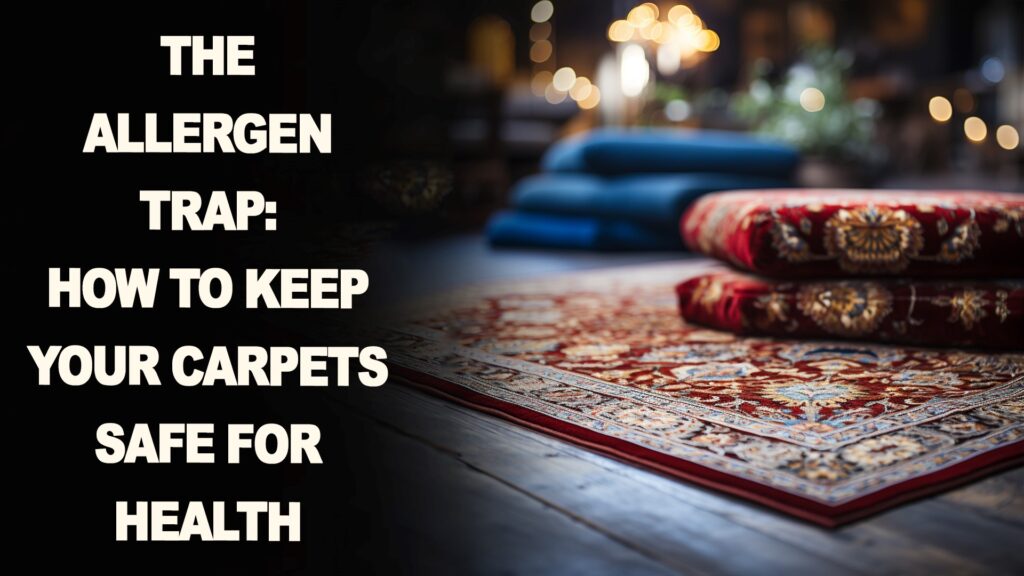
Introduction
In the tapestry of modern living, the comforts of home are often synonymous with wellness and sanctuary. Among the fixtures that add to the aesthetic and sensory warmth of our abodes, carpets hold a place of prominence. Yet, beneath their plush façade, carpets can harbor a multitude of allergens—microscopic invaders that can stealthily compromise the health of a household.
The conversation around allergens in the home is not new, yet it is ever-evolving, as is our understanding of the role that carpets play in allergen accumulation. From the dust mite’s reign to the silent spread of mold spores, carpets can be both the unsuspecting hosts and the unwitting conduits for allergens. This brings to light a pressing question: How can we enjoy the beauty and comfort of carpeted floors while safeguarding our health?
In the following sections, we will delve deep into the world of carpet allergens, their impact on health, and the innovative solutions available to mitigate their effects. Through a confluence of science, technology, and proactive measures, this article aims to unfurl the hidden dangers and weave a path toward healthier living spaces.
Identifying Common Carpet Allergens
The domestic landscape is more biodiverse than we might expect. Carpets, with their dense, fibrous architecture, act as a catch-all for an array of microscopic entities that are largely invisible to the naked eye yet potent in their effects.
Dust Mites: Tiny Creatures, Big Allergies Dust mites are the quintessential carpet dwellers. These minute arachnids thrive in warm, humid environments, feasting on the dead skin cells we shed daily. Their feces and decaying bodies become part of the household dust, which, when inhaled, can trigger allergic reactions and asthmatic responses. The prevalence of dust mite allergies underscores the need for targeted strategies to reduce their population in our homes.
Pet Dander and Its Persistent Presence For pet owners, the joys of furry companionship come with an additional set of challenges. Pet dander—composed of tiny, even microscopic, flecks of skin shed by cats, dogs, rodents, birds, and other animals with fur or feathers—is another common carpet allergen. These particles can cling to a variety of surfaces, carpets being a major one, and they retain their allergenic potential for a long time.
Pollen and Outdoor Allergens Inside the Home While pollen is typically associated with the outdoors, it finds its way into our homes through open windows, doors, and on clothing. Once inside, it settles into carpets, adding to the allergen load. For those with seasonal allergies, this transference can turn what should be a refuge into a source of discomfort.
Mold Spores in the fiber carpets can also become breeding grounds for molds if moisture is present. Mold spores, like other allergens, are not discerning; they will infiltrate the home environment and propagate in the carpet, waiting to be disturbed and inhaled, leading to respiratory issues and allergic reactions.The Health Risks Associated with Carpet Allergens

Allergens are not merely inconveniences; they pose veritable threats to health, particularly to the respiratory system. The risks associated with carpet allergens extend from acute allergic reactions to the potential for chronic health conditions.
Short-Term Effects on Respiratory Health Immediate responses to allergens can range from sneezing, coughing, and itchy eyes to severe asthmatic attacks. For those with existing respiratory conditions, these allergens can exacerbate symptoms, leading to increased medication use and medical interventions.
Long-Term Allergen Exposure and Chronic Conditions Beyond the immediate reactions lies a more insidious risk. Prolonged exposure to allergens has been linked to the development of chronic respiratory diseases such as asthma and could potentially influence the severity of these conditions over time.
Vulnerable Groups: Children and the Elderly Certain demographics, including children, the elderly, and immunocompromised individuals, are particularly susceptible to the effects of indoor allergens. For children, whose immune and respiratory systems are still developing, early exposure to allergens can have lasting health implications.
The Hidden Costs of Indoor Allergens The burden of allergens is not only measured in health terms but also in the economic impact related to healthcare costs and lost productivity. This further underscores the need for allergen management in home settings.
Strategies for Reducing Allergen Accumulation
Confronting the allergen issue requires a multifaceted approach, combining daily habits, cleaning strategies, and technological interventions to reduce the allergen burden.
Proper Carpet Selection to Minimize Allergens The journey to a healthier home environment begins with carpet selection. Opting for carpets with a low pile and tightly woven fibers can make it harder for allergens to settle and easier for them to be removed. Additionally, some carpets come treated with substances that deter dust mites and other allergens, offering an extra layer of defense.The Importance of Regular Cleaning Routines

Regular and thorough cleaning is paramount in the fight against allergens. This goes beyond mere vacuuming; it includes deep cleaning practices that can extract allergens from within the carpet’s pile.
Advanced Vacuuming Techniques Choosing the right vacuum cleaner is essential. Models equipped with HEPA (High-Efficiency Particulate Air) filters can capture a greater number of small particles, effectively reducing the amount of dust and allergens that recirculate in the air during cleaning.
Professional Cleaning and Its Advantages While routine home cleaning is important, professional cleaning services have the tools and techniques to perform deep cleanses that may not be possible with domestic equipment. Periodic professional cleanings can significantly lower allergen levels in carpets.
The Role of Humidity Control in Allergen Reduction
Maintaining optimal indoor humidity levels is not just about comfort; it’s a critical factor in allergen control. Dust mites and molds, for example, thrive in high humidity, so keeping indoor air dry is crucial.
Dehumidifiers and Their Impact on Indoor Allergens Utilizing dehumidifiers can help maintain a level of humidity that is less hospitable to mites and mold. By keeping indoor humidity below 50%, we can inhibit the life cycle of dust mites and reduce the likelihood of mold growth.
Ventilation to Combat Moisture Accumulation Good ventilation goes hand in hand with humidity control. Ensuring a steady exchange of indoor and outdoor air helps to keep moisture levels in check and reduces potential allergen buildup. This is particularly important in areas like bathrooms and kitchens, where moisture is more prevalent.
Smart Home Systems for Monitoring Environmental Conditions Modern smart home systems often include features that monitor and adjust humidity and ventilation. These systems can provide alerts when conditions are prime for allergen proliferation, empowering homeowners to take preventive action.
Emerging Technologies in Carpet Allergen Reduction
The fight against allergens is being bolstered by advancements in technology, offering new tools and methods to keep our homes healthier.
Antimicrobial Carpet Treatments Recent developments in carpet treatments include the application of antimicrobial agents that can inhibit the growth of bacteria, mold, and mildew directly within carpet fibers, thus reducing the potential for allergen accumulation.
Ultraviolet Light for Allergen Destruction Ultraviolet (UV) light has been shown to destroy various bacteria and viruses. Some modern vacuum cleaners now incorporate UV light technology to kill dust mites and other allergens on the carpet surface, adding an extra layer of protection during cleaning routines.
Innovations in Vacuum Technology Vacuum manufacturers continue to innovate, with new models offering greater suction, advanced filtration systems, and features designed specifically to target allergens. These innovations make the vacuums more effective at removing allergens from carpet fibers.
Allergen-Proof Carpet Underlays The underlay of a carpet can also play a role in allergen management. New materials designed to prevent the growth of mold and bacteria are becoming more common, providing an additional barrier against allergens beneath the carpet itself.
A Holistic Approach to Allergen Management
While individual strategies are important, an integrated approach that encompasses the home environment as a whole offers the best protection against allergens.
Combining Cleaning, Lifestyle, and Design Choices Allergen management extends beyond cleaning. It includes lifestyle choices, such as removing shoes at the door to prevent pollen and other outdoor allergens from entering, as well as design decisions, like opting for easy-to-clean surfaces in high-traffic areas.
Fostering an Allergen-Aware Household Education is key. All members of the household should be aware of the sources of allergens and the steps necessary to minimize their impact. This can range from proper pet grooming to prevent dander to understanding the importance of regular carpet maintenance.
Choosing Appropriate Home Furnishings and Decor In addition to carpets, other home furnishings, and décor choices can affect indoor allergen levels. For example, selecting window treatments that are easy to clean and don’t accumulate dust can help reduce the overall allergen load in the home.
Professional Allergen Testing and Assessment For those with severe allergies or respiratory conditions, professional allergen testing and assessment can provide a detailed understanding of the allergens present in the home and help tailor a specific management strategy to address them.
Conclusion
Carpets can enrich our living spaces with texture, color, and warmth, but without proper care, they can also harbor allergens that pose health risks. Understanding the various allergens common to carpets and implementing a comprehensive strategy to mitigate them is crucial for maintaining a healthy indoor environment.
From selecting the right carpet materials to embracing technological innovations and fostering an allergen-aware lifestyle, there are many steps homeowners can take to reduce the impact of allergens. By doing so, we not only protect our health but also enhance the comfort and enjoyment of our homes.
As our knowledge of allergens and the technology available to combat them advances, we can look forward to a future where carpets and clean, allergen-free air coexist, supporting both our physical well-being and our desire for a beautiful, comfortable living space.